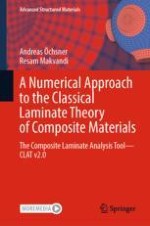This book first provides a systematic and thorough introduction to the classical laminate theory for composite materials based on the theory for plane elasticity elements and classical (shear-rigid) plate elements. The focus is on unidirectional lamina which can be described based on orthotropic constitutive equations and their composition to layered laminates. In addition to the elastic behavior, failure is investigated based on the maximum stress, maximum strain, Tsai-Hill, and the Tsai-Wu criteria.
The solution of the fundamental equations of the classical laminate theory is connected with extensive matrix operations, and many problems require in addition iteration loops. Thus, a classical hand calculation of related problems is extremely time consuming. In order to facilitate the application of the classical laminate theory, we decided to provide a Python-based computational tool, the so-called Composite Laminate Analysis Tool (CLAT) to easily solve some standard questions from the context of fiber-reinforced composites. The tool runs in any standard web browser and offers a user-friendly interface with many post-processing options. The functionality comprises stress and strain analysis of lamina and laminates, derivation of off-axis elastic properties of lamina, and the failure analysis based on different criteria.
